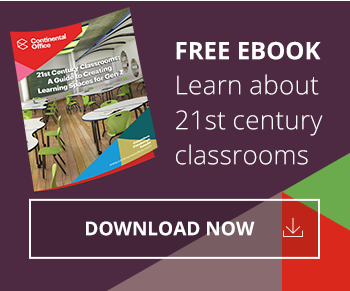Active learning is described as a “teaching method that strives to more directly involve students in the learning process.” This is contrasted with passive learning, in which students simply sit and listen to a teacher speak, or watch some sort of presentation or video. There is a place for passive learning, but more and more teachers are experimenting with active learning to boost their students’ educational attainment.
With active learning, students are encouraged not only to listen and absorb information, but to actively read, write, discuss, and solve practical problems. By applying their knowledge, students get to think more about what they are doing and learning, which helps to increase retention rates. In order to facilitate this teaching method, teachers are experimenting with classroom designs and flexible seating that fosters greater participation and heightened focus. So, how exactly do these elements inspire active learning?
Flexible Furniture
Traditional seating usually signifies a passive approach when it comes to education. In rigid, immovable chairs, students are expected to sit up straight and listen to their teachers for long periods of time. While perceived as economical for many schools, there are many problems with this method. Sitting in rigid, static chairs tends to fatigue the muscles and reduce circulation in the body, which causes marked decreases in attention and concentration along with lapses in memory retention. Couple this with the fact that students are having to sit for a long period of time and listen, and you can see how students might not be learning as much as they should.
Now consider adjustable soft furniture and the active learning method. Students are at their best when they are able to constantly move and get comfortable in their own personalized ways. When students are in constant motion, they experience better circulation and comfort, which improves attention, concentration, and memory. Adjustable ergonomic seating allows students to make changes to their seats in order to remain comfortable and engaged. Because ergonomic furniture allows a greater range of movement, it lets students shift positions throughout the day as they see fit in ways that encourage good posture while reducing muscle or joint strain.
Additionally, active learning methods encourage students to move between different activities fluidly and quickly so their attention doesn’t have a chance to drift elsewhere. Easily-movable seating and furniture allows students to quickly rearrange their seating so they can best participate in a given activity.
Movable Class Arrangements
Another element to the active learning method is a flexible class arrangement, in which teachers are free to organize their classrooms in any number of ways to shift between lessons, presentations, and learning styles to accommodate group work and individual learning. For example, comfy couches and quiet hideaway sections can be used for reading, while circular tables and face-to-face desks can encourage collaborative group activity.
A mobile whiteboard is well-suited to this approach as well. Teachers can wheel the board to the front of the room for lectures and demonstrations, and it can easily be turned over to students for presentations or group activities.
The same is the case with blackboards and electronic surfaces. Dual surfaces and rotating surfaces allow for quick repositioning and shifting between subjects. This is the essence of active learning: constant motion and a shifting between activities, keeping students aware and stimulated.
Better Schools
 Teaching methods and educational designs have come a long way in the last couple of decades. The active learning method has been developed far beyond what traditional passive methods were capable of, and dynamic classroom designs are catching up with these key ideas. Flexible furniture and mobile tools are quickly becoming standard fare in these powerful new teaching methods.
Teaching methods and educational designs have come a long way in the last couple of decades. The active learning method has been developed far beyond what traditional passive methods were capable of, and dynamic classroom designs are catching up with these key ideas. Flexible furniture and mobile tools are quickly becoming standard fare in these powerful new teaching methods.
Above all else, students will benefit the most from these promising changes. Teachers and educational administrators need only incorporate these ideas into their own classrooms and watch as their students' retention rates and academic achievements rise.
This is a guest post and may not represent the views of Continental Office.





Comments